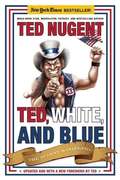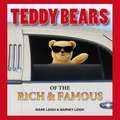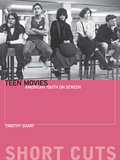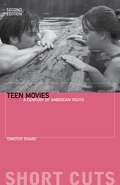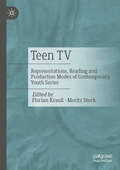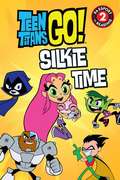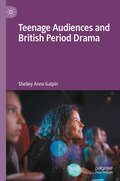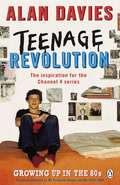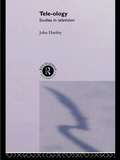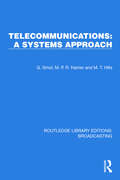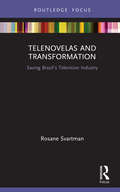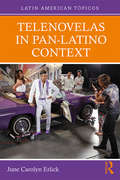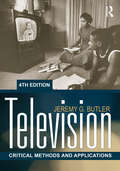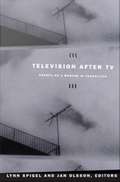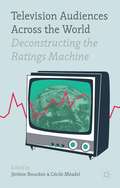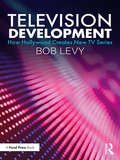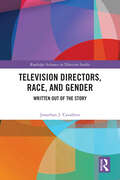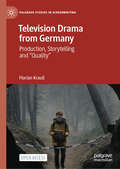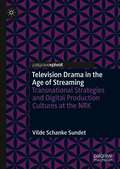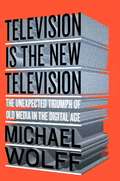- Table View
- List View
Technology, Monstrosity, and Reproduction in Twenty-First Century Horror
by Kimberly JacksonThrough a wide spectrum of horror sub-genres, this book examines how the current state of horror reflects the anxieties in Western culture. Horror films bring them to a mass audience and offer new figures for the nameless faceless 'antagonist' that plagues us and provides material with which to build a different understanding of ourselves.
Ted, White and Blue: The Nugent Manifesto
by Ted NugentAnother hell-raising book by the famous rocker, where he comments on the state of USA and how to fix many of our problems
Teddy Bears of the Rich and Famous
by Mark LeighA fantastic gift book for all ages which imagines what the teddy bears of the rich and famous would look like.Even the most tyrannical of despots or the most scholarly of geniuses probably had a 'Mister Cuddles' or 'Big Ted' at some point in their childhood. As the book's title suggests, this is a collection of bears that could have belonged to the rich and famous. Whether it's politicians, heads of state, artists, spiritual leaders, inventors, revolutionaries, entertainers or entrepreneurs, the teddy bears reflect the personalities/traits of their owners.
Teen Movies
by Timothy SharyTeen Movies: American Youth on Screen is a detailed look at the depiction of teens on film and its impact throughout film's history. Timothy Shary looks at the development of the teen movie -- the rebellion, the romance, the sex and the horror -- up to contemporary portrayals of ever-changing youth. Films studied include Rebel Without a Cause (1955), Splendor in the Grass (1961), Carrie (1976), The Breakfast Club (1985), and American Pie (1999).
Teen Movies: A Century of American Youth (Short Cuts)
by Timothy SharyCinema has always engaged with the experiences, hopes, fears, and anxieties of—and about—adolescents, teenagers, and young people. This book is a comprehensive and accessible history of the depiction of teenagers in American film, from the silent era to the twenty-first century.Timothy Shary explores the development of teenage roles across eras and industrial cycles, such as the juvenile delinquent pictures of the 1950s, the beach movies of the 1960s, the horror films of the 1980s, and the fantasy epics of the 2000s. He considers the varied genres of the teen movie—horror and melodrama, romance and adventure, fantasy and science fiction—and its shifting themes and tropes around sex and gender, childhood and adulthood, rebellion and social order, crime and consumer culture. Teen Movies features analyses of films such as Rebel Without a Cause (1955), Splendor in the Grass (1961), Carrie (1976), The Breakfast Club (1985), American Pie (1999), and the Twilight series (2008–2012).This second edition is updated throughout and features a new chapter examining Millennials and Generation Z on screen, with discussions of many contemporary topics, including queer youth in movies like Moonlight (2016), abortion in films such as Never Rarely Sometimes Always (2020), and the flourishing of a “tween” cinema as seen in Are You There God? It’s Me, Margaret. (2023).
Teen Movies: American Youth on Screen (Short Cuts)
by Timothy Shary Rob McInnesTeen Movies: American Youth on Screen is a detailed look at the depiction of teens on film and its impact throughout film's history. Timothy Shary looks at the development of the teen movie – the rebellion, the romance, the sex and the horror – up to contemporary portrayals of ever-changing youth. Films studied include Rebel Without a Cause (1955), Splendor in the Grass (1961), Carrie (1976), The Breakfast Club (1985), and American Pie (1999).
Teen TV: Representations, Reading and Production Modes of Contemporary Youth Series
by Florian Krauß Moritz StockTeen TV is booming. Current youth series on streaming platforms are a clear indication of this, but have so far received little attention in German-language media studies. This anthology provides a fundamental introduction to serial teen TV and takes a look at central case studies, from 13 Reasons Why to DRUCK, the German adaptation of the Norwegian transmedia youth drama SKAM. In addition to the content and aesthetics of serial teen narratives, it looks at their reception and production contexts.
Teen TV: Repräsentationen, Lesarten und Produktionsweisen aktueller Jugendserien
by Florian Krauß Moritz StockDas Teen TV boomt. Aktuelle Jugendserien auf Streaming-Plattformen sind dafür ein klares Indiz, haben in der deutschsprachigen Medienwissenschaft bislang aber kaum Beachtung gefunden. Dieser Sammelband führt grundlegend in das serielle Teen TV ein und nimmt zentrale Fallbeispiele in den Blick, von 13 Reasons Why bis zu DRUCK, der deutschen Adaption des norwegischen Transmedia-Jugenddramas SKAM. Neben den Inhalten und der Ästhetik der seriellen Jugendnarrationen geht es um ihre Rezeption und um Produktionskontexte.
Teen Titans Go! (TM): Silkie Time
by Magnolia BelleLearn about the Teen Titans' mascot and everybody's favorite worm, Silkie! Passport to Reading Level 2 TM & © DC Comics. (s17)
Teenage Audiences and British Period Drama
by Shelley Anne GalpinThis book provides an engaging insight into the responses of teenage audiences to British period drama, presenting original data collected from young people across England. Situated in relation to debates regarding the heritage film and young people’s consumption of the media, Teenage Audiences and British Period Drama challenges the often homogenous characterisation of teenagers by demonstrating the range of responses this genre inspires in young viewers. Arguing for the period drama’s underestimated relevance to younger audiences, the book details the varied ways that young people use film and television drama to make sense of the world and their place in it, and highlights the under-researched significance of collective viewing in influencing viewer response. Analysis demonstrates the key role that values play in influencing judgements amongst youth audiences, the importance of perceived historical accuracy and the potential for screen texts to inspire a deeper relationship with the past.
Teenage Revolution
by Alan DaviesWhen Alan Davies was growing up he seemed to drive his family mad. 'What are we going to do with you?' they would ask - as if he might know the answer.Perhaps it was because he came of age in the 1980s. That decade of big hair, greed, camp music, mass unemployment, social unrest and truly shameful trousers was confusing for teenagers. There was a lot to believe in - so much to stand for, or stand against - and Alan decided to join anything with the word 'anti' in it. He was looking for heroes to guide him (relatively) unscathed into adulthood.From his chronic kleptomania to the moving search for his mother's grave years after she died; from his obsession with joining (going so far as to become a member of Chickens Lib) to his first forays into making people laugh (not always intentionally); Teenage Revolution is a touching and funny return to the formative years that make us all.
Teenagers From Outer Space
by Mike PondsmithSo How Does a Six-Armed Green-Skinned Guy from Arcturus Get a Date on a Saturday Night? Yo, dude! Aliens from Beyond the Stars have invaded our planet! They're enrolling their kids in our schools, shopping in our shopping malls, and hanging out in our fast food joints! High school is never going to be the same again. Six-armed green-skinned guys from Arcturus are gonna date your kid sister! Silicon-based lifeforms are gonna poke their school lunch and wonder what it's supposed to be! On second thought, maybe high school won't be so different after all. What Is This Thing? Teenagers from Outer Space is a roleplaying game set on an Earth where fun-loving space aliens go to our high schools and party with the Earth kids. In the game you play the part of a teenager-alien or human-and have adventures fighting mutant monstrosities, saving the world from ravening rabbits from the X dimension, and getting your homework in on time. You're not a gamer? No sweat, dude. Teenagers is a giggle. You'll have fun reading it, even if you never play. (Honest. Hey, trust us on this one, okay?) And if you decide to play, it'll be a snap. Unlike other roleplaying games, Teenagers doesn't have encyclopedia-long rules that you have to study like a textbook before you can play. You can learn to play this thing in minutes. Seconds, even. . . . Well, okay, maybe not seconds. And if you are a gamer-hey, butchering orcs is swell for a while, but isn't it time for a change of pace? Dragons are dangerous and dungeons are deadly, but there's nothing quite as awesome, quite as fearful, quite as horrifying as an order to report to...the principal's office!
Tele-ology: Studies in Television
by John HartleyTeleology brings together John Hartley's work on television. The book draws on current critical theory in cultural studies to develop a wide-ranging and thought-provoking view of television broadcasting in Britain, Australia and the USA.Neighbours, Hancock's Half Hour, Dallas, Monty Python, Miami Vice, Beverly Hillbillies and Bonanza are among the examples of TV art that are discussed in Hartley's exploration of cultural politics. He takes in TV truth and propaganda; populism in the news; mythologies of the audience; TV drama as a `photopoetic' genre in the tradition of Shakespeare; Kylie Minogue, Madonna and gardening shows.
Telecommunications in Developing Countries: The Challenge from Brazil (Routledge Library Editions: Broadcasting #34)
by Michael HobdayTelecommunications in Developing Countries (1990) stresses the importance of modern, micro electronics-based telecommunications for developing economies in providing a basic communications infrastructure for economic and industrial development and the springboard for new information technology activities. Although progress in telecommunications has so far been concentrated in the most advanced regions of the world, some developing countries can bypass older, less efficient forms of telecommunications and go straight to microelectronic technology. This book is the first to examine the challenges and difficulties facing developing countries in this field. extending existing theories of technology transfer and diffusion, Michael Hobday offers an explanation of the forces for change in the telecommunications industry. He then examines Brazil's experience in telecommunications, from developing the technology and building up a modern infrastructure to controlling multinational suppliers of equipment. Dr Hobday explains why Brazil's efforts in this area have succeeded, and offers lessons for other developing countries.
Telecommunications: A Systems Approach (Routledge Library Editions: Broadcasting #33)
by G. Smol M.P.R. Hamer M.T. HillsTelecommunications: A Systems Approach (1976) uses two extended case studies, of public telephone and television systems, in order to introduce the basic ideas of telecommunication systems. It describes the application of a number of techniques within the context of practical telecommunications systems, and takes into account the needs of the users of these systems and the economic constraints which affect the choice of techniques and the overall system structure.
Telenovelas and Transformation: Saving Brazil’s Television Industry (Routledge Advances in Transmedia Studies)
by Rosane SvartmanThis book investigates how telenovelas may be the key to the future of Brazilian television and how this content can survive in an interconnected media landscape. Recognised telenovela writer and scholar Rosane Svartman considers the particular characteristics of the telenovela format – number of episodes, melodrama influence, and influence of the audience on future writing – to explore how these can be preserved on multimedia platforms, and the challenges this change may present. Svartman further charts the transformations of the telenovela throughout its history and its major influences and unveils the main storytelling elements and writing processes. Chapters examine the business model of Brazilian corporate television within the current context of hypermedia and analyse how this relationship evolves as it is influenced by the new interactive tools and technologies that amplify the audience’s power. Merging empirical practices and theory, this book will be of great interest to scholars and students of transmedia storytelling, television studies, and Latin American media, as well as professionals working in these areas.
Telenovelas in Pan-Latino Context (Latin American Tópicos)
by June Carolyn ErlickThis concise book provides an accessible overview of the history of the telenovela in Latin America within a pan-Latino context, including the way the genre crosses borders between Latin America and the United States. Telenovelas, a distinct variety of soap operas originating in Latin America, take up key issues of race, class, sexual identity and violence, interweaving stories with melodramatic romance and quests for identity. June Carolyn Erlick examines the social implications of telenovela themes in the context of the evolution of television as an integral part of the modernization of Latin American countries.
Television
by Jeremy G. ButlerFor nearly two decades, Television: Critical Methods and Applications has served as the foremost guide to television studies. Designed for the television studies course in communication and media studies curricula, Television explains in depth how television programs and commercials are made and how they function as producers of meaning. Author Jeremy G. Butler shows the ways in which camera style, lighting, set design, editing, and sound combine to produce meanings that viewers take away from their television experience. He supplies students with a whole toolbox of implements to disassemble television and read between the lines, teaching them to incorporate critical thinking into their own television viewing. The fourth edition builds upon the pedagogy of previous editions to best accommodate current modes of understanding and teaching television. Highlights of the fourth edition include: New chapter and part organization to reflect the current approach to teaching television--with greatly expanded methods and theories chapters. An entirely new chapter on modes of production and their impact on what you see on the screen. Discussions integrated throughout on the latest developments in television's on-going convergence with other media, such as material on transmedia storytelling and YouTube's impact on video distribution. Over three hundred printed illustrations, including new and better quality frame grabs of recent television shows and commercials. A companion website featuring color frame grabs, a glossary, flash cards, and editing and sound exercises for students, as well as PowerPoint presentations, sample syllabi and other materials for instructors. Links to online videos that support examples in the text are also provided. With its distinctive approach to examining television, Television is appropriate for courses in television studies, media criticism, and general critical studies.
Television After TV: Essays on a Medium in Transition
by Lynn Spigel Jan OlssonIn the last ten years, television has reinvented itself in numerous ways. The demise of the U. S. three-network system, the rise of multi-channel cable and global satellite delivery, changes in regulation policies and ownership rules, technological innovations in screen design, and the development of digital systems like TiVo have combined to transform the practice we call watching tv. If tv refers to the technologies, program forms, government policies, and practices of looking associated with the medium in its classic public service and three-network age, it appears that we are now entering a new phase of television. Exploring these changes, the essays in this collection consider the future of television in the United States and Europe and the scholarship and activism focused on it. With historical, critical, and speculative essays by some of the leading television and media scholars, Television after TV examines both commercial and public service traditions and evaluates their dual (and some say merging) fates in our global, digital culture of convergence. The essays explore a broad range of topics, including contemporary programming and advertising strategies, the use of television and the Internet among diasporic and minority populations, the innovations of new technologies like TiVo, the rise of program forms from reality tv to lifestyle programs, television's changing role in public places and at home, the Internet's use as a means of social activism, and television's role in education and the arts. In dialogue with previous media theorists and historians, the contributors collectively rethink the goals of media scholarship, pointing toward new ways of accounting for television's past, present, and future. Contributors William Boddy Charlotte Brunsdon John T. Caldwell Michael Curtin Julie D'Acci Anna Everett Jostein Gripsrud John Hartley Anna McCarthy David Morley Jan Olsson Priscilla Pea Ovalle Lisa Parks Jeffrey Sconce Lynn Spigel William Uricchio
Television Audiences Across the World: Deconstructing the Ratings Machine
by Cécile Méadel Jérôme BourdonThis book is the first to deal with the world composition of television ratings. It focuses on the peoplemeter, a 25 year old technology which succeeds in homogenizing very different populations and television practices. It provides a fascinating account of the production of figures on which the whole world of popular culture depends.
Television Development: How Hollywood Creates New TV Series
by Bob LevyDevelopment is a large and central part of the American TV industry, and yet the details of how it works – who makes development decisions and why, where ideas for new shows come from, even basics like the differences between what TV studios and TV networks do – remain elusive to many. In this book, lecturer and acclaimed television producer Bob Levy offers a detailed introduction to television development, the process by which the Hollywood TV industry creates new scripted series. Written both for students and industry professionals, Television Development serves as a comprehensive introduction to all facets of the development process: the terminology, timelines, personnel and industrial processes that take a new TV project from idea to pitch to script to pilot to series. In addition to describing these processes, Levy also examines creative strategies for successful development, and teaches readers how to apply these strategies to their own careers and speak the language of development across all forms of visual storytelling. Written by the renowned producer responsible for developing and executive producing Gossip Girl and Pretty Little Liars, Television Development is an essential starting point for students, executives, agents, producers, directors and writers to learn how new series are created. Accompanying online material includes sample pitches, pilot scripts, and other development documents.
Television Directors, Race, and Gender: Written Out of the Story (Routledge Advances in Television Studies)
by Jonathan J. CavalleroThis book challenges the predominant framing of US television as a writer’s or producer’s medium by suggesting that television directors are a vital component of TV artistry.Looking beyond a perspective that favors the narrative and economic aspects of television but undervalues the medium’s formal elements, the book explores how directors use the visual and aural to contribute layers of meaning that add to the thematic development of television texts. Starting from the belief that television aesthetics partially reveal the ways in which directors (and their collaborators) contribute to the overall thematic development of a program, the author offers five case studies that map out the ways that directors have contributed to television drama throughout the medium’s approximately 80-year history. By devoting special attention to the presence and voices of directors from marginalized backgrounds, the book creates opportunities to discuss television from perspectives that emphasize issues of diversity, equity, and inclusion.This original and insightful work will appeal to students and scholars of television studies, television production and media production, critical media studies, media authorship, gender studies, and race and media.
Television Drama from Germany: Production, Storytelling and "Quality" (Palgrave Studies in Screenwriting)
by Florian KraußThis open access book examines how TV professionals in Germany have negotiated “quality TV drama” from 2015 to the present. As practitioners have adapted quality TV – a term most strongly associated with US series – to their own national context, they have simultaneously dealt with shifts in screenwriting and storytelling as well as with broader transformations of the local television industry. As in other European countries, in Germany this has included a crucial upheaval: the emergence of various streaming services, which has multiplied the television market. As a systematic study of this changing fiction industry, Television Drama from Germany will be of great interest to both academics and practitioners working both within and outside the German-language television market.
Television Drama in the Age of Streaming: Transnational Strategies and Digital Production Cultures at the NRK
by Vilde Schanke SundetThis book examines television drama in the age of streaming—a time when television has been reshaped for national and international consumption via both linear ‘flow’ and on-demand user modes. It builds on an in-depth study of the Norwegian public service broadcaster (NRK) and some of its game-changing drama productions (Lilyhammer, SKAM, blank). The book portrays the formative first decade of television streaming (2010-2019), how new streaming services and incumbent television providers intersect and act in a new drama landscape, and how streaming impacts existing television production cultures, publishing models and industry-audience relations. The analysis draws on insight gained through more than a hundred interviews with television experts and fans, hundreds of hours of observations, and unique access to industry conferences, meetings, working documents, and ratings. The book combines perspectives from production studies, media industry studies, and fan studies to inform its analysis.
Television Is the New Television
by Michael Wolff"The closer the new media future gets, the further victory appears." --Michael WolffThis is a book about what happens when the smartest people in the room decide something is inevitable, and yet it doesn't come to pass. What happens when omens have been misread, tea leaves misinterpreted, gurus embarrassed?Twenty years after the Netscape IPO, ten years after the birth of YouTube, and five years after the first iPad, the Internet has still not destroyed the giants of old media. CBS, News Corp, Disney, Comcast, Time Warner, and their peers are still alive, kicking, and making big bucks. The New York Times still earns far more from print ads than from digital ads. Super Bowl commercials are more valuable than ever. Banner ad space on Yahoo can be bought for a relative pittance.Sure, the darlings of new media--Buzzfeed, HuffPo, Politico, and many more--keep attracting ever more traffic, in some cases truly phenomenal traffic. But as Michael Wolff shows in this fascinating and sure-to-be-controversial book, their buzz and venture financing rounds are based on assumptions that were wrong from the start, and become more wrong with each passing year. The consequences of this folly are far reaching for anyone who cares about good journalism, enjoys bingeing on Netflix, works with advertising, or plans to have a role in the future of the Internet.Wolff set out to write an honest guide to the changing media landscape, based on a clear-eyed evaluation of who really makes money and how. His conclusion: the Web, social media, and various mobile platforms are not the new television. Television is the new television.We all know that Google and Facebook are thriving by selling online ads--but they're aggregators, not content creators. As major brands conclude that banner ads next to text basically don't work, the value of digital traffic to content-driven sites has plummeted, while the value of a television audience continues to rise. Even if millions now watch television on their phones via their Netflix, Hulu, and HBO GO apps, that doesn't change the balance of power. Television by any other name is the game everybody is trying to win--including outlets like The Wall Street Journal that never used to play the game at all.Drawing on his unparalleled sources in corner offices from Rockefeller Center to Beverly Hills, Wolff tells us what's really going on, which emperors have no clothes, and which supposed geniuses are due for a major fall. Whether he riles you or makes you cheer, his book will change how you think about media, technology, and the way we live now.From the Hardcover edition.

